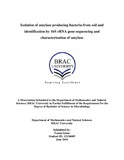| dc.contributor.advisor | Khan, Trosporsha Tasnim | |
| dc.contributor.advisor | Hossain, Dr. Mahboob | |
| dc.contributor.author | Islam, Tasnia | |
| dc.date.accessioned | 2017-05-08T06:11:54Z | |
| dc.date.available | 2017-05-08T06:11:54Z | |
| dc.date.copyright | 2016 | |
| dc.date.issued | 2016-06 | |
| dc.identifier.other | ID 12126005 | |
| dc.identifier.uri | http://hdl.handle.net/10361/8103 | |
| dc.description | This Thesis is submitted in partial fulfillment of the requirements for the degree of Bachelor of Science in Biotechnology, 2016. | en_US |
| dc.description | Cataloged from PDF version of thesis report. | |
| dc.description | Includes bibliographical references (page 57-60). | |
| dc.description.abstract | The use of amylase enzyme has been extensive in different industrial sectors for quite a long time because of its multifarious applications. Unfortunately, Bangladesh lacks any local production of amylase although many industries are highly dependent on the enzyme. In this study, bacteria from soil sample were primarily screened on starch agar medium to identify any amylase producer through the detection of a clear zone around the bacterial colony after adding Gram’s iodine. Out of 48 isolates, 17 were observed to produce amylase but only two isolates, 14 and 28 were selected based on the highest clear zone ratio. The two isolates were further screened by monitoring their enzyme activities using the DNS method and specific enzyme activities using Folin-Lowry method. Since isolate 14 showed a higher enzyme activity (0.123 U/ml) and specific enzyme activity (0.173 U/mg), it was chosen as the bacteria to be worked with. Gram staining and spore staining revealed that this isolate is Gram positive, rod shaped, arranged singly and in chains and forms endospores. Colony morphology and biochemical profile were also conducted in order to identify the bacteria presumptively. Finally, genotypic identification was performed via the 16S rRNA gene sequencing. The bacterial DNA was extracted and its 16S rRNA gene was amplified via Polymerase Chain Reaction using 27F and 1492R universal primers. The DNA containing the gene was observed to be about 1,650 bp in length. Sanger sequencing method was used to sequence the DNA which revealed that it had a length of 1,436 bp. Furthermore, NCBI nucleotide BLAST website was used to align this sequence with the sequences of other bacteria in the database through which it was determined that isolate 14 belongs to the genus Bacillus. A phylogenetic tree was also constructed to determine the species of isolate 14 which revealed that isolate 14 is a strain of Bacillus cereus. Further investigation was carried out to characterize the amylase enzyme produced by this bacterial isolate. It was observed that the optimum temperature of the enzyme is 75°C while the optimum pH is 7. This indicated that the enzyme requires a moderately high temperature and neutral pH to show greatest activity. | en_US |
| dc.description.statementofresponsibility | Tasnia Islam | |
| dc.format.extent | 69 pages | |
| dc.language.iso | en | en_US |
| dc.publisher | BRAC University | en_US |
| dc.rights | BRAC University thesis are protected by copyright. They may be viewed from this source for any purpose, but reproduction or distribution in any format is prohibited without written permission. | |
| dc.subject | | en_US |
| dc.subject | Bacteria | en_US |
| dc.subject | Soil | en_US |
| dc.subject | Gene sequencing | en_US |
| dc.title | Isolation of amylase producing bacteria from soil and identification by 16S rRNA gene sequencing and characterization of amylase | en_US |
| dc.type | Thesis | en_US |
| dc.contributor.department | Department of Mathematics and Natural Sciences, BRAC University | |
| dc.description.degree | B. Biotechnology | |

